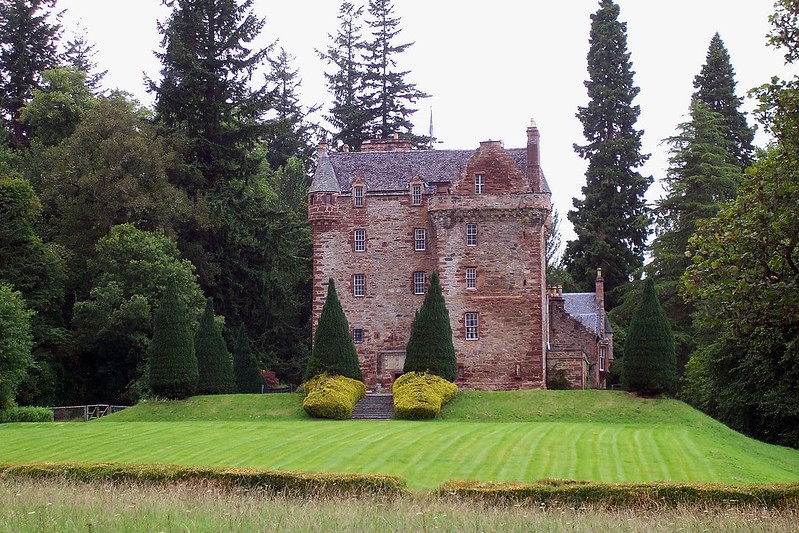
Motto: Luceo non uro (I shine not burn)
Historic Seat: Castle Leod
District: Ross-shire
Associated Surnames: Charles, Kenneth, Kennethson, MacBeolain, MacConach, MacKerlich, MacMurchie, MacMurchy, MacVanish, MacVinish, Smart
Associated Tartans:
Early Mackenzie Genealogy and History:
(Excerpt from "The Scottish Clans and Their Tartans", James Grant, 1906)
The descent of the chief of this clan – "MacKenneth, great Earl of the North, The Lord of Loch Carron, Glenshiel, and Seaforth," is of pure Scoto-Gaelic descent, with a strain of Irish, as asserted by Douglas and others. In the "Iona Club Transactions"1 their descent in 1450 is given as follows: "The genealogy of the Clan Kenneth – Murdoch, son of Kenneth, son of John, son of Kenneth, son of Angus, son of Christian, son of Adam, son of Gilleoin-Oig of the Aird."
In Robertson's "Index of Missing Charters" there is a Crown Charter of Confirmation by David II for the lands of "Kintale" in 1344, when a grant of that and other lands by William Earl of Ross, to Reginald, son of Roderick de Insulis, dated 1342, 4th July, is confirmed. In MacKenzie's "History of the Clan" the earliest date which can be assigned for its acquisition of Kintail from John, Earl of Ross, is 1463. After the forfeiture of the Lords of the Isles, the clan, like all others in the West became independent.
Alexander, seventh chief of Kintail, accompanied James I in his expedition to the north in 1426. He was ancestor of the MacKenzies of Logie, Hilton, and Gairloch, and died in 1488.
John, the ninth chief, followed James IV to Flodden2 with a body of his clan, and narrowly escaped being made prisoner. He was faithful to Mary of Guise, Queen Regent, fought in his old age at Pinkie,3 and died in 1554.
Colin, eleventh chief, fought bravely for Queen Mary at the battle of Langside,4 for which he was afterwards pardoned by the Regent Murray.
Kenneth, his eldest son by Barbara Grant of that Ilk, was raised to the Peerage in 1609 as Lord MacKenzie of Kintail. From these descended the MacKenzies of Pluscardine and Lochslyne, according to Douglas. Colin, their eldest son, was created Earl of Seaforth in 1623. He and his brother John of Lochslyne, dying without issue, the title devolved on his half-brother, George, by a charter under the Great Seal. He went to Holland after the murder of Charles I, and was subsequently Secretary of State for Scotland.
Kenneth, fourth Earl, was one of the Privy Council to King James VII, and K.T. in 1687. He followed to Ireland and to France his Royal master through war and exile, and was created Marquis of Seaforth; but as his patent had not passed the Great Seal of Scotland, the title was only recognised by the Jacobites. He died in 1701, and was succeeded by William, fifth Earl, who was attainted5 in 1715, and was at the battle of Glenshiel6 in 1719, when a rising in Scotland, aided by a few Spanish Infantry, was concerted by the Marquis of Tullibardine and the Earl Marishcal.
Earl William, after the insurrection of 1715, made his escape to France, where he remained till George I granted him a pardon for his life in 1726, after which he returned to Scotland, and spent the remainder of his life in peace and retirement. He died in 1740, and would have been succeeded by his son Kenneth, Lord Fortrose, as sixth Earl, but for the attainder.
The fighting force of the MacKenzies is given by Forbes at 2500 men, adding those of the Earl of Cromartie and the Lairds of Gairloch, Skatwell, Kilcowie, Redcastle, and Comrie, all MacKenzies.
Kenneth, son of Lord Fortrose, having repurchased the property from the Crown, was created an Irish Peer as Viscount Fortrose, and in 1771 was restored to the Earldom of Seaforth. In gratitude, therefore, he and the clan of the Caberfey, as the MacKenzies are called, in 1778 raised the old Seaforth Highlanders, afterwards numbered as the 72nd, 1000 strong, for service in India. In 1793 the clan, under Humberston MacKenzie, who died Earl of Seaforth in 1816, raised the "78th," or famous Ross-shire Buffs, and now both regiments are formed in one, as the 1st and 2nd Battalions of "the Duke of Albany's Seaforth Highlanders."
The Chieftainship and the Earldom were claimed by MacKenzie-Fowler of Allangrange; but now Anne (only child of John Hay MacKenzie of Cromartie and Newhall), Mistress of the Robes to Her Majesty (1870-74), Duchess of Sutherland, became in her own right (1861), Countess of Cromartie, Viscountess Tarbet, Baroness MacLeod and Castlehaven.
Kenneth MacKenzie of Gairloch was created a Bart.7 in 1629, and there are six other Baronetcies borne by members of the clan.
In the field of literature we cannot forget Sir Alexander MacKenzie, the traveller, 1781-1816; George, author of the "Writers of the Scots Nation;" and more than all, Henry, who was author of "The Man of Feeling."
The above-named Anne, Countess of Cromartie, died in 1888, and was succeeded by her second son, Francis, as Earl of Cromrtie, etc. He died in 1893, and his elder daughter Sibell, was declared in March 1895 to hold all her father's titles, and so is Countess of Cromartie.
(End excerpt)
Next page: Clan MacKinnon
Footnotes:
1 Iona Club Transactions: Collectanea de Rebus Albanicis, a book printed in 1847 for members of a Scottish society, relating to the history of the Highlands and islands of Scotland. Free eBook available at Google Books.
2 The Battle of Flodden (1513): The Battle of Flodden Field was fought on 9 September 1513, in Northumberland England between an army of Scots under King James IV and an English army commanded by the Earl of Surrey. Read more about the Battle of Flodden at Wikipedia.
3 The Battle of Pinkie Cleugh (1547): The Battle of Pinkie Cleugh was fought on 10 September 1547 on the banks of the River Esk near Musselburgh, Scotland. It was the last pitched battle between Scottish and English armies, and was a defeat for Scotland. Read more about the Battle of Pinkie Cleugh at Wikipedia.
4 The Battle of Langside (1568): The Battle of Langside was fought on 13 May 1568 between forces loyal to Mary Queen of Scots and forces acting in the name of her infant son James VI. Read more about the Battle of Langside at Wikipedia.
5 Attainted: Stripped of titles, hereditary rights, and/or possessions.
6 The Battle of Glen Shiel (1719) The battle of Glen Shiel was fought on 10 June 1719 in the Scottish Highlands, between a Jacobite army and Spanish marines, and a government force of troops. It resulted in a government victory and an end to the 1719 Jacobite Rebellion. Read more about the Battle of Glen Shiel at Wikipedia.
7 Bart.: Baronet
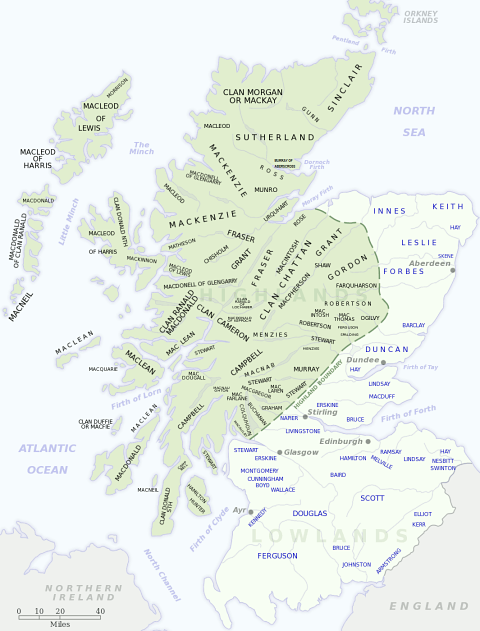
Distribution of Scottish clans and families
View larger map at Wikimedia Commons
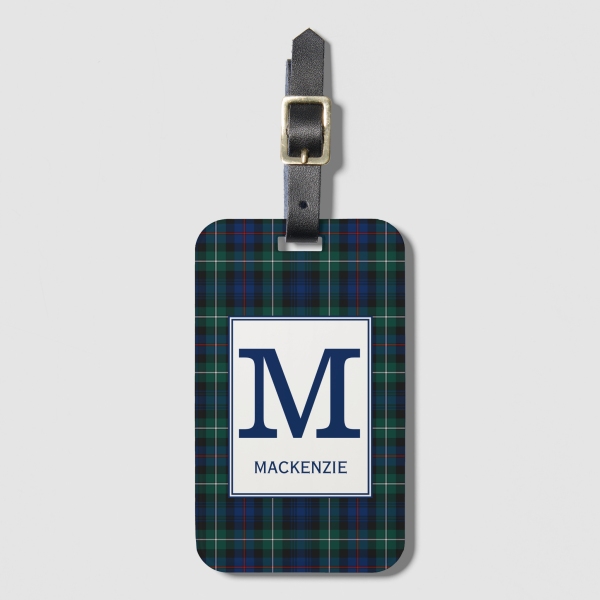
Browse the Clan Mackenzie Tartan Collection with home decor, personal accessories, crafting, paper products, and more.
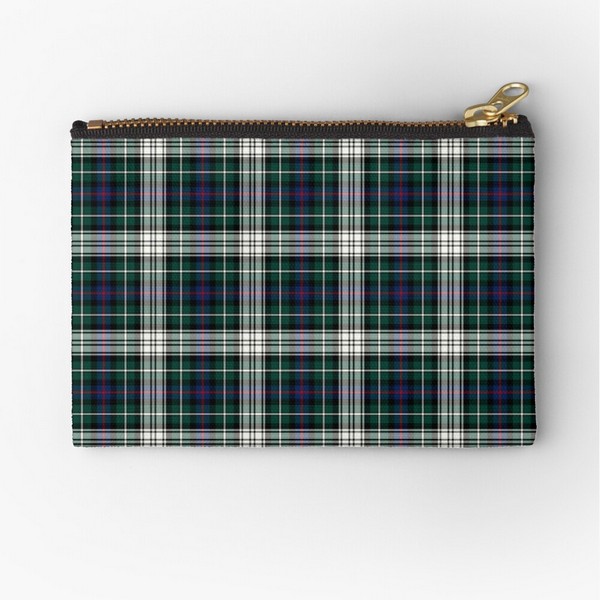
Browse the Clan Mackenzie Dress Tartan Collection with clothing, home decor, accessories, electronics cases, and more.
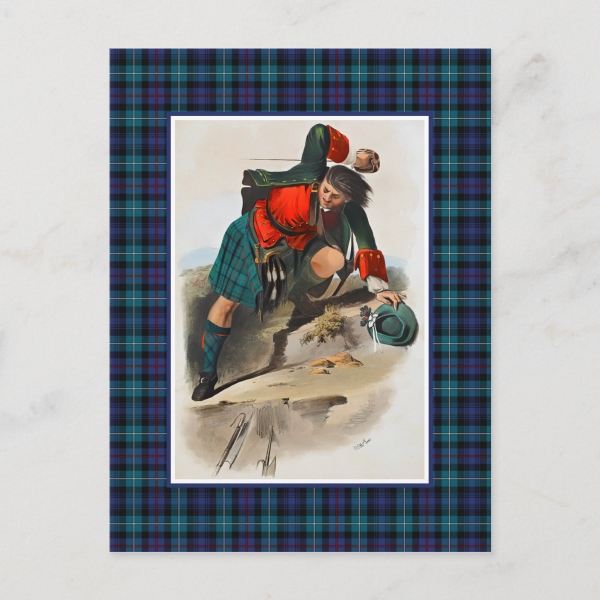
Clan Mackenzie Postcard: Digitally cleaned and enhanced vintage illustration with tartan border.